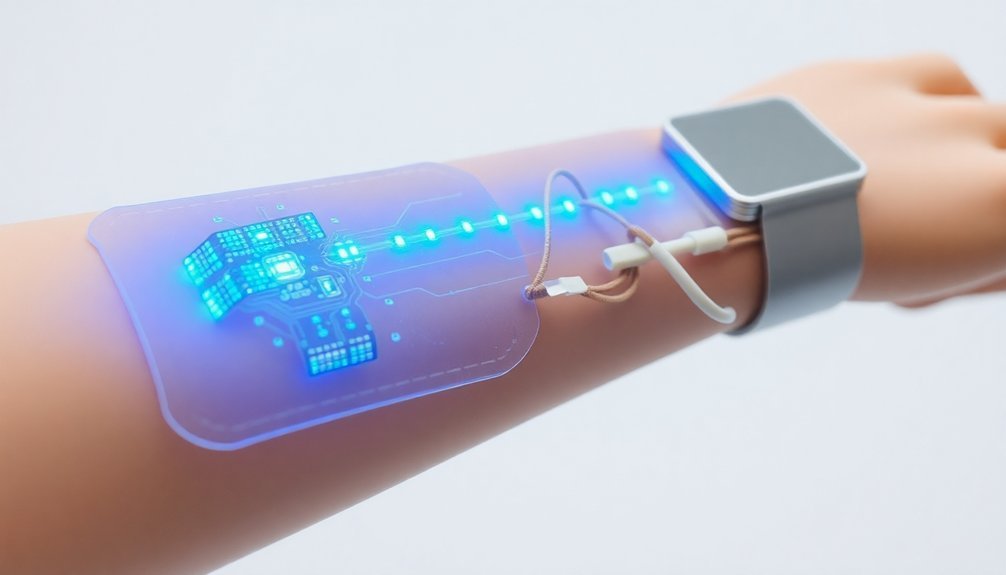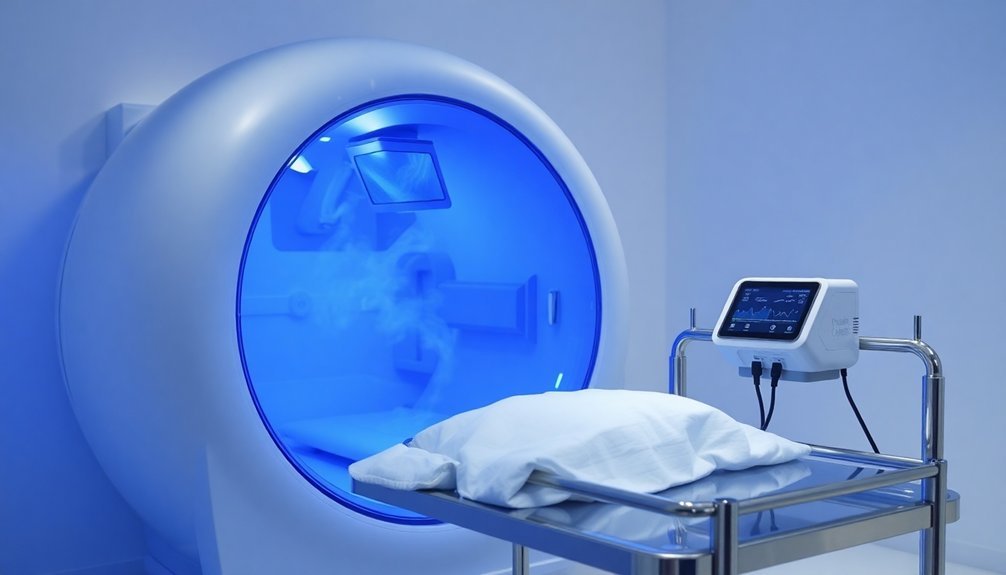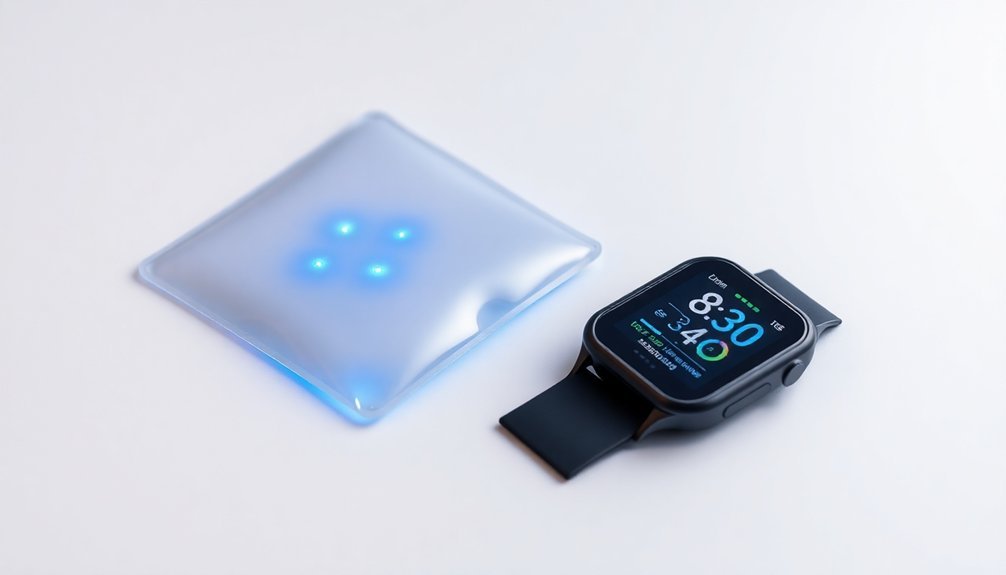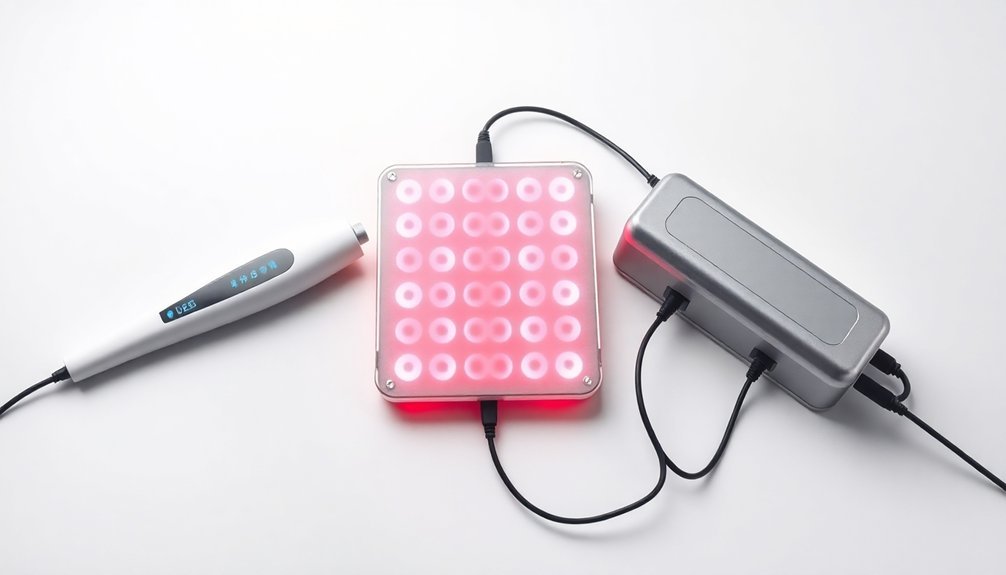Modern wound healing devices can dramatically speed up your recovery and reduce pain. You'll find electric healing bandages that stimulate cellular repair and boost blood flow, cutting healing time by 30%. Electrotherapy wound systems restore natural bioelectric currents while providing pain relief. Oxygen-based treatments, including hyperbaric chambers, enhance immune function and achieve impressive 90% closure rates. Advanced pressure technology creates ideal healing environments through vacuum-assisted closure. Smart wearable devices monitor your wound's condition and automatically dispense medication when needed. Discover how these innovative technologies can transform your healing journey.
Electric Healing Bandages

Electric healing bandages revolutionize wound care by delivering gentle electrical stimulation directly to injury sites. These innovative devices can heal chronic wounds 30% faster than traditional bandages while remaining surprisingly affordable at just a few dollars per dressing.
You'll find they're particularly effective for treating stubborn conditions like diabetic ulcers and other hard-to-heal wounds.
What makes these bandages special is their sophisticated technology. They use bioelectric signals to boost cellular activity and improve blood flow, while some versions even harness energy from your body's natural movements through nanogenerators.
You'll appreciate their flexible design, which conforms to your wound's surface, and many models are completely disposable with integrated electrodes.
Beyond faster healing, you'll benefit from reduced pain and better infection control, as these bandages create an environment that bacteria don't like. Some advanced versions can monitor your wound's condition in real-time and release medication when needed.
While animal studies have shown promising results, especially in diabetic mice, researchers are continuing to develop these bandages with new features like antibacterial nanomaterials and integration with wearable technology to provide even better wound care solutions.
Electrotherapy Wound Systems
Through advanced bioelectric technology, modern electrotherapy wound systems deliver precise electrical stimulation to accelerate healing and reduce pain. These systems work by restoring the natural bioelectric current that's disrupted when you're injured, enhancing blood flow and tissue oxygenation while promoting cellular regeneration.
You'll find these devices particularly effective for treating chronic wounds, as they create an environment that supports healing and fights bacterial infections.
The systems use carefully calibrated electrical frequencies and amplitudes, with electrodes placed strategically around your wound to conduct healing currents through the tissue.
- The devices stimulate vital cellular processes, including fibroblast production, collagen synthesis, and growth factor generation
- Treatment sessions are customizable, with portable units allowing you to receive therapy at home
- Clinical studies show significant improvements in healing rates, especially for diabetic ulcers and pressure injuries
- Most systems offer automatic pulsed stimulation that can continue working for up to 12 days
When using electrotherapy wound systems, you'll typically notice reduced pain levels and faster healing compared to traditional wound care methods alone. These devices integrate seamlessly with standard treatment protocols, offering you a non-invasive path to recovery.
Oxygen-Based Wound Treatment

Modern oxygen-based wound treatments offer two powerful approaches to accelerate healing: hyperbaric oxygen therapy (HBOT) and topical oxygen therapy (TOT).
HBOT delivers 100% oxygen through a pressurized chamber during 1-2 hour sessions, which you'll typically undergo multiple times per week for up to 30 sessions. This treatment enhances your immune function, promotes tissue regeneration, and reduces swelling in the wound area.
TOT provides a different approach by applying pure oxygen directly to your wound's surface at normal atmospheric pressure. You can receive TOT either intermittently (90-minute sessions, 3-5 days weekly) or continuously (24/7), using high-flow oxygen concentrators or portable generators.
Studies show TOT achieves impressive closure rates of 73-90% while reducing pain and infection risks.
Both methods work by increasing oxygen availability to your damaged tissues, which speeds up healing by promoting blood vessel growth and collagen production. While HBOT has more extensive research backing its effectiveness, TOT's convenience and strong clinical outcomes make it an attractive option.
Your doctor will determine which approach best suits your specific wound condition, considering factors like wound type, severity, and your overall health status.
Advanced Pressure Technology
Advanced pressure therapy revolutionizes wound healing through two core mechanisms: controlled air pressure and vacuum technology. These devices create an ideal healing environment by applying precise pressure to stimulate blood flow while removing debris and bacteria from the wound site. The system's specialized polyurethane dressings ensure optimal sealing and drainage management.
When you're dealing with complex or large wounds, advanced pressure technology offers significant advantages over traditional treatments. It's particularly effective at managing fluid drainage and reducing bacterial contamination, which are essential factors in successful wound healing.
Here are the key benefits you'll experience with advanced pressure therapy:
- Faster healing rates through enhanced blood flow and oxygen delivery to the wound site
- Reduced risk of complications, including infections and potential amputations
- Improved formation of granulation tissue, essential for wound closure
- Significant reduction in wound size compared to conventional treatments
Clinical studies consistently show that negative pressure wound therapy (NPWT) accelerates recovery, especially for chronic and infected wounds. You'll find this technology particularly useful for vascular wounds and closed surgical incisions.
With ongoing developments in fluid instillation and advanced dressings, pressure therapy continues to evolve, offering you even more effective treatment options.
Smart Wearables For Healing

Smart wearable technology has transformed wound care by combining real-time monitoring with automated treatment delivery. These innovative bandages use advanced bioelectronic materials and hydrogels to track your wound's pH, temperature, and bacterial presence while automatically dispensing medication when needed.
You'll benefit from miniaturized needle arrays that precisely deliver drugs and collect fluid samples, while flexible polymer structures guarantee a comfortable, conforming fit. The bandages can even apply electrical stimulation to promote tissue growth, substantially speeding up your healing process.
What makes these devices particularly effective is their ability to detect potential complications before they become serious. You'll experience reduced pain and faster recovery times thanks to the real-time intervention capabilities.
The smart bandages continuously collect and analyze data, allowing for personalized treatment adjustments based on your specific healing progress.
While researchers continue to improve these devices' stability and test them on larger wounds, you can expect to see more advanced features in the future. The integration of nanomaterials and bioengineered skin substitutes promises even more effective wound care solutions, potentially reducing your healthcare costs through more efficient wound management.
Frequently Asked Questions
How Long Should Each Device Be Used Daily for Optimal Healing Results?
You'll need Accel-Heal for 48 hours per device over 12 days, NPWT changed every 48 hours for 1-7 weeks, and RecoveryRx continuously for 24 hours daily until healing's complete.
Are These Devices Covered by Insurance or Medicare/Medicaid?
You'll find Medicare Part B covers NPWT devices, paying 80% of approved costs while you pay 20%. Other wound care devices may be covered if they're medically necessary and prescribed by your healthcare provider.
Can Multiple Wound Healing Devices Be Used Simultaneously on Different Wounds?
Yes, you can use multiple wound healing devices simultaneously on different wounds, but you'll need to verify device compatibility and consult your healthcare provider about potential interactions and proper placement for each wound.
What Are the Maintenance Costs and Battery Life for These Devices?
You'll find maintenance costs vary, including canister replacements and cleaning supplies. Battery life typically ranges from 14-48 hours, with devices like the V.A.C. Simplicity offering 14 hours and Nisus NPWT lasting 24-48 hours.
Can These Devices Be Safely Used on Patients With Pacemakers?
You'll need to consult your doctor before using wound recovery devices with a pacemaker. While most devices are safe, electromagnetic interference risks exist. Always follow manufacturer guidelines and get professional medical clearance first.
In Summary
You've got powerful options to accelerate your wound healing with these innovative devices. Whether you choose electric bandages, electrotherapy systems, oxygen treatments, pressure technology, or smart wearables, you'll find scientifically-proven solutions to support faster recovery. Talk to your healthcare provider about which device best suits your specific wound type and healing needs. Don't let slow-healing wounds hold you back when these technologies can help.





Leave a Reply